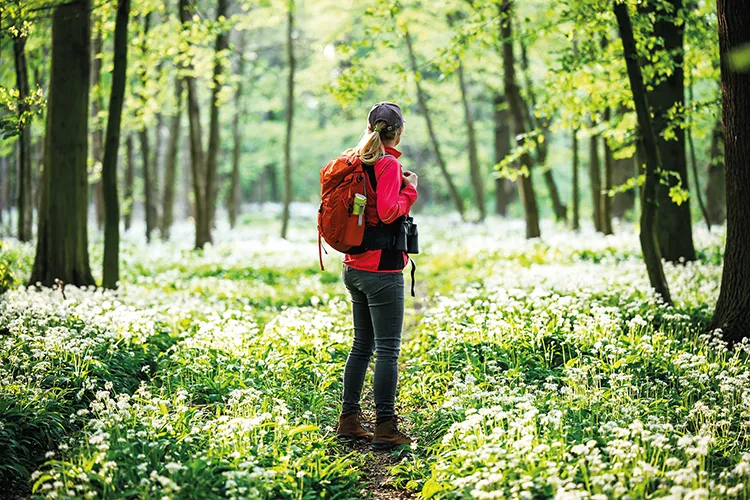
Tristan Kennedy on observing nature as the world wakes up after winter
There are few places in the world that take springtime as seriously as Japan. As the season approaches, the Japan Meteorological Corporation – the country’s equivalent of the Met Office – takes time out from predicting storms to issue regular cherry blossom forecasts. On 3 April, shortly before this column went to print, they published the 11th of the year. This finessed their previous estimates, letting people know to the day, if not the minute, when the first blossoms were likely to appear in their region.
The arrival of the pale pink flowers, known as sakura, has been celebrated for well over 1,000 years in Japan. The custom of holding hanami – parties beneath blossoming cherry trees – is reckoned to date from the Nara period, between 710 CE and 794 CE. The blossoms, which often last for little more than a week, symbolise both the beauty and the transience of human existence in traditional Japanese culture – as well as the inevitability of rebirth and renewal. The arrival of spring is seen as a chance to meditate on the ephemeral nature of life, as well as to celebrate new beginnings.
Today, cherry blossom season attracts hundreds of thousands to hanami held in city parks and other outdoor spaces each year. It’s become a serious business, not just for locals but for tourists, too. Visitor numbers spike every year for the brief period when the trees are in flower – hence the importance of getting those forecasts absolutely nailed on.
This combination of modern meteorological technology and ancient philosophical underpinnings might be uniquely Japanese, but of course, you don’t have to travel as far as the Land of the Rising Sun to appreciate the beauty of blossoms in spring.
As a new father, I’ve recently been spending a lot more time than usual in my local park, pushing the pram around the same loop on an almost daily basis as I try to persuade my recalcitrant son to sleep. It makes a change from the kind of walks I’d usually be doing at this time of year, when the warmer weather and longer days make lengthy, multi-day hikes pleasant again. But covering the same ground over and over at a glacial pace means that I’ve noticed things that I might not usually have done.
I’ve watched the snow melt steadily off the mountains in the distance and the leaves on their slopes turn green, seemingly in real time. I haven’t been carrying around binoculars, as I usually would on longer walks, but I reckon I’ve consciously heard and identified more bird species in the park than ever before. And for the first time, I could tell you – with a precision that would make a Japanese meteorologist proud – the exact moment that the local cherry trees came into bloom. Of course, I’ve always known that one of the greatest pleasures of hiking in the spring is watching the changing of the seasons. But walking more slowly and repeating my steps on a near-daily basis has thrown it into a whole new relief.
Science has repeatedly shown that spending time outdoors has a hugely beneficial effect on human health and wellbeing. A 2019 study by researchers from the University of Exeter Medical School showed that ‘the likelihood of reporting good health or high wellbeing became significantly greater’ among those who spent 120 minutes or more in nature every week – even if it was just a stroll around a park.
There’s also a growing body of research that suggests that taking time out to notice nature is what’s really important. Studies led by Professor Miles Richardson, from the University of Derby’s School of Psychology, have shown that participants with common mental health issues reported improvements when they were asked to simply record three things about the natural world around them every day for a week.
Enjoying this article? Check out our related reads:
Consciously observing nature like this, I would argue, is easier than ever in spring, when the almost daily changes make you sit up and take notice. And this holds true whether you’re heading out on a gruelling multi-day hike in the mountains or pushing a pram around an urban park.
There are other things that my now-regular short strolls and my usual long spring hikes have in common, too. Buggy and baby accoutrements aside, the gear I take is roughly the same. A decent rain jacket is essential at this time of year, when the weather can turn on a dime. Footwear that can handle mud is key, and I still make sure to carry water with me – in fact, my Thermos has become more important than ever, now that I have to keep water warm for baby formula rather than just my own tea.
Of course, my attention is first and foremost on the baby when we’re out. And there are times when looking at the trees, birds and flowers is the last thing on my mind. But the way he stares in wonder at the world around him helps me see it in new ways, and once he nods off, the slower pace makes it far easier to slip into a meditative mood. Thinking about new beginnings is perhaps inevitable when you’re pushing a pram. But you don’t need a new baby to appreciate the simple joy of being outdoors in spring. The seriousness with which Japan treats the sakura season might seem strange at first glance, but I think they’re onto something.
Wishlist – three items that will make spring walks better
The Luxury: Hamilton Khaki Field Mechanical Watch – £840

Designed specifically for outdoor adventurers, the Hamilton Khaki Field Mechanical Watch takes its design cues from the military. The NATO-style strap, which loops through the back of the watch head and doubles back on itself, ensures that the watch can’t fall off, even if it gets snagged or caught. The compact, 38-millimetre face sits well on any wrist, and the large numerals and Super-LumiNova hands make it easy to read, even at night. The model shown here is one of several new colour combinations, which have earth-coloured cases, green and brown straps, and dials in black, white or green.
hamilton.com
The Surprisingly Useful: Leica Ultravid Compact Colorline 10×25 Binoculars – £990

Small and compact, but with impressive magnifying power and crystal-clear Leica lenses, this incredibly versatile pair of binoculars ticks a lot of boxes. As the brand itself puts it, they’ve been ‘developed for style-conscious cosmopolitans, nature lovers, and culture enthusiasts,’ and as such can be taken anywhere. They’re available in two sizes and two colourways – Capri Blue and Apple Green. The larger pair we’ve chosen here combines 10x magnifying power and a 25-millimetre front lens diameter, weigh just 255 grams and measure 11.1 x 11.2 x 3.9 centimetres, making them easy to slip into a coat pocket or stash in a backpack. As you’d expect from the German brand, the lenses are top notch, featuring maximum colour brilliance and image sharpness.
leica.com
The Essential: Blundstone #2058 All-Terrain Chelsea Boots – £210

Proper footwear is always the first port of call when you’re talking about walking gear – especially in springtime, when paths are more likely to be muddy. These elegant-looking Chelsea boots are perfect for springtime park walks, combining urban-friendly styling with a chunky Vibram sole that can handle seriously slippery trails. They’re made by Blundstone, a brand from Tasmania that has been in business for more than 150 years. The uppers are made of water-resistant, 1.8-millimetre thick treated leather to keep your feet dry. And the boots’ silhouette is deliberately simple.




